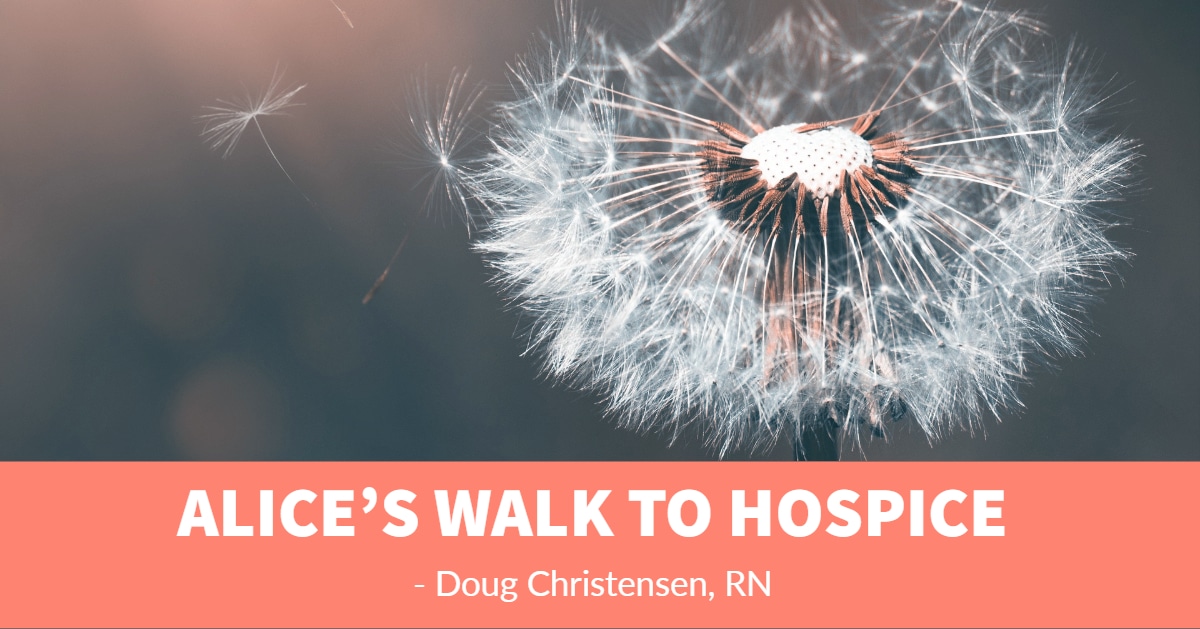Alice’s Walk to Hospice
by Doug Christensen, RN
As a Suncrest Field Specialist, it is my responsibility and goal to assess prospective patients for hospice appropriateness. I work to determine if I can make a reasonable argument that a patient will no longer be with us within six months if their disease process is to take its natural course. When I go into an assessment with this in mind, I’m amazed at how much, at first glance, a new patient can appear completely hospice appropriate, perhaps even close to death; but sometimes looks can be deceiving, as a more detailed, objective assessment can paint a far different picture.
Take Alice, who, at 68-years old, had lived in Colorado most of her life. Alice and her husband were avid outdoor enthusiasts. They participated in many year-round sporting events, as well as actively engaging in sporting activities with kids and grandkids. Last summer, Alice and her husband were biking a popular trail when Alice lost control of her bike, landing in such a manner that broke her neck and left her paralyzed from the waist down, a complete quadriplegic. This was a game changer in their active lifestyle – a lifestyle which she would never get the chance to enjoy again.
Following the accident, Alice was in and out of hospitals, clinics, and rehab, spending countless hours and financial resources on surgeries, procedures, therapy, and equipment, all in an attempt to simply, or not-so-simply, stabilize her health and manage the external support that helps her breathe and maintain life.
She relied on a diaphragmatic stimulator that helped her abdominal muscles expand and contract while she was seated in her wheelchair, so she can breathe as efficiently as possible. During nights, Alice utilized a ventilation system to keep her lungs functioning. She had to be mechanically lifted and positioned in and out of bed very carefully, especially when switching over from one assistive breathing device to another. Her blood pressure was prone to drop suddenly, so vital signs had to be checked often and medication given if blood pressure values were out of range.
“I almost felt like I had failed this family…”
Alice’s husband was her primary caretaker and did a remarkable job of keeping Alice stable, maintaining equipment, and meeting all of her needs. Alice also had 24-hour professional caregivers and loving family members that assisted in her care, but by far it was Alice’s husband who was her faithful, dependable lifeline to the world, committed to her health and well-being, despite the crippling injury she had sustained and the drastic lifestyle change they had both endured.
As I began my assessment of Alice, she expressed how fiercely independent she had been before the accident; how her independence has shaped her whole life and allowed her to be successful, raise a family, enjoy all that the immense Colorado outdoors could offer. But now all that has changed, and she must rely on the careful combination of caregivers, medications and machinery to stay alive, down to the breathing apparatus and oxygen that assists her lungs to get enough air. Doctors have failed to provide Alice any appreciable prognosis, given the professional, caring, and exceptional medical attention she’s received, most notably her husband’s insistence at procuring the best support he could find and provide.
“She expressed how fiercely independent she had been before the accident.”
During my assessment of Alice, I found her to be a small, petite woman. She appeared under-nourished, almost gaunt, but her weight was stable. Alice was completely aware of her surroundings, with no impairment or decline in cognition since the accident, only the inability to feel the rest of her body. She had no issues with eating, could swallow and digest food naturally, but every bite had to be hand fed. Her normal fluid intake capacity was insufficient, so she was given additional hydration through a feeding tube.
Alice also performed physical therapy every day, together with husband and therapists, to keep good range of motion and maintain muscle tone. Because of her healthy lifestyle pre-accident, her heart and lungs were in excellent shape; she literally had no negative health history. But despite all the therapeutic interventions, Alice expressed that she had already reached the pinnacle of her physical baseline and knew her body was beginning to weaken, despite the absence of feeling. You see, she was still one with her body; she could instinctively hear and feel its inner workings and decreasing endurance, an internal decline that she sensed and understood was worsening.
With this in mind, Alice verbalized she was coming to terms with her mortality and physical limitations, and was now in full consideration of invoking her right to refuse any further life-sustaining treatments, to include the life-support systems her body must rely on every day. She did not know how or when that refusal would take place but wanted to be prepared and thought hospice would be a good starting point. I agreed.
I wrote up my assessment notes – Alice’s health history, her intention of discontinuing life support, diving deep into the whole, “Why Hospice, Why Now?” discussion. I wrote my notes thinking to myself, how much more decline could she have? This was a very fragile patient. If any of her equipment malfunctioned, if a plug or tube suddenly came loose and disconnected without immediate discovery, death could be nearly instantaneous.
I reported to my medical director with the most thorough and convincing assessment note I could write, describing how this accident had ravaged and taken everything from this patient; how it was now beginning to take its toll on her will to live and ability to thrive. I had to convince him this patient was appropriate for hospice, as his final approval was required before she could be admitted. Yet, despite the fragility of her condition, ultimately the medical director said no, she was not eligible at that time.
You see, all this life support – the therapy, individualized attention her husband, family, and caregivers were able to provide – it kept her stable enough that she was not able to meet the guidelines for hospice admission. She could reasonably expect to live much longer than six months, as long as all the sophisticated life support equipment, caregivers, and providers did not fail her; but most of all it depended on Alice, her will to survive and her body’s ability to remain healthy.
Despite not meeting criteria physically, she still could have come onto our service during that initial visit by invoking her right to refuse life support services. She had lost control of basically everything in her once-independent life, and the one thing she did have control of was the single-most difficult decision of all, but one that she was not quite prepared to make. Therefore, I could not admit her at that time to provide the additional support she desired, but assured her I would certainly be her advocate when that time did come.
Both Alice and her husband expressed disappointment at not meeting hospice criteria, and I almost felt like I had failed this family because, despite Alice’s history of good health, she could intuitively feel herself declining, her failure to thrive, and recognize her body was weakening, regardless of the tireless efforts of keeping her at baseline. Even though Alice still had the will to live, her body was not able to keep up with the rigorous life-support efforts of struggling to maintain the integrity of her health. She felt the increasing physical weakness, coupled with the decreased endurance of spirit, was a sign that she needed to prepare herself, her husband and family for her departure; she just needed a little more time, so hospice would have to wait a bit longer.
“Alice’s case is rare, as most hospice patients don’t get to decide when their time comes.”
About a month following my initial visit, Alice was admitted onto Suncrest Hospice services, as she finally made the decision to discontinue life support and was making a determination on the best date to proceed. She had been putting her affairs in order and also wanted to ensure the best, most comfortable method in sequencing the termination of life support. When she and her family fully accepted her decision, they could focus on keeping Alice comfortable instead of aggressive attempts to increase her longevity.
Being on hospice allowed Alice to relax and make each day as comfortable as possible as she put the final touches on her life. With Suncrest Hospice’s interdisciplinary team of aides, nurses, social workers, and spiritual care providers, she now had that extra care and support to help guide and ensure the most comfortable journey for her spirit to move on. This was Alice’s right to make that decision; the right to be free instead of fighting for each breath; the right to refuse a life of total dependence; and the right to be released from suffering the confinement of a broken body.
Alice’s case is rare, as most hospice patients don’t get to decide when their time comes. The best we can do in most cases is to help patients live out the rest of their lives in the most comfortable manner that we can provide. As providers and caregivers, we are not used to the thought of someone planning their own demise and actively carrying it out, as it is our duty and commitment to help heal. But we are also committed to advocating for the patient, their desires and wishes, then supporting their decisions; even challenging decisions like the ones Alice faced and came to terms with. May she, and all of our patients, find peace, freedom, and rest at the end of their journey.
Sold Out hospice stories on our hospice blog
Please feel free to contact us with any questions regarding hospice care


